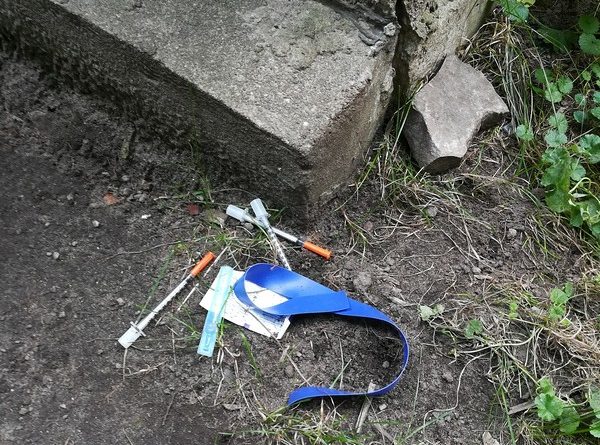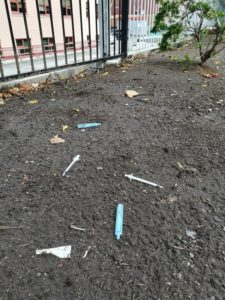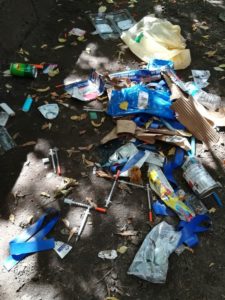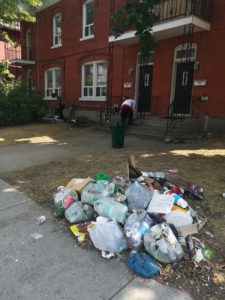Special Report – What’s up with all these needles?
Ralph Blaine
As most residents of Sandy Hill know, a Supervised Injection Site (SIS) opened on the premises of the Sandy Hill Community Health Centre (SHCHC) in April 2018. There were naturally concerns in the community, but we hoped that the SIS could manage the comings and goings of their clients without undue spillover effects in the community. Alas, this proved not to be the case. First there appeared a semi-permanent camp next to the Pizza Pizza restaurant. Trash accumulated in the environs of the clinic and nearby residents began to report unwelcome intrusions onto their property. The details of what happened next were reported in a comprehensive series of stories by Larry Newman, beginning in the October 2019 issue of IMAGE. The upshot was that the SIS hired security guards to supervise the area around the clinic; the Pizza Pizza camp disappeared and a NO LOITERING sign was posted in its place. A semblance of order returned to Nelson and Besserer Streets.
But this summer the situation around the clinic seemed to be shifting. There was often a small crowd gathered around the No Loitering sign; there was a growing amount of litter and garbage around the clinic and across the street on Besserer, where another knot of people were gathered. I became increasingly curious about what was going on, and over the summer I had conversations with several members of the SIS network: security guards, police officers, local residents, drug users, Community Outreach volunteers and the administration of the SIS.
One day I met two fellows with plastic bags roving over the sidewalk area on Besserer, adjacent to the clinic’s parking lot, who gave me a crash course in drug paraphernalia litter. Andy and Philly told me they were cleaning up. Andy said they were doing this “on their own” and pointedly insisted, “Just because we are drug addicts doesn’t mean we have to behave like animals.”
They explained that the thin orange plastic tubes scattered on the ground were needle guards for syringes, while the milky plastic caps cover the plunger of a new syringe. If that plastic cap is not attached, the syringe has been used. There were also numerous light blue tubes scattered about. These had contained distilled water used to dissolve drugs before injection. All of these objects, plus the syringes themselves, could easily be found next to the Pizza Pizza fence, in the surrounding streets and alleys, as well as the front and back yard of the row at 302-306 Besserer.
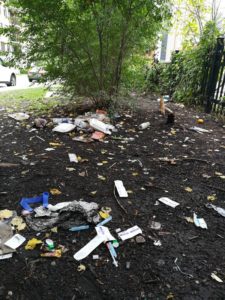
Photo by Ralph Blaine
I got a bit more insight into the litter situation one day when I was taking a picture of a discarded syringe on Besserer Street. Alexander, one of the SHCHC security guards, approached me.
He wanted to tell me that people from an organization called Needle Hunters came around every evening to pick up the needles. He also introduced me to Cat, an employee of the SHCHC, who invited me inside and gave a quick explanation of some of what the SIS does.
The SIS makes a point of educating its clientele about safe drug use. They also give out kits containing the blue vials of distilled water, the necessary equipment to safely dissolve drugs before injection, syringes, secure boxes to store and return used syringes to the clinic, pipes for users of crack and meth, and a host of other personal hygiene items. The fact that clients can take this equipment with them as they leave seems to be a tacit admission that the SIS itself cannot service, inside its doors, all the needs of the intravenous drug users in the area for supervised injections.
When I asked Cat why people in the community were still finding syringes lying about the streets and sidewalks despite the disposal boxes SIS provides, she said, in so many words, that people who are high just don’t always have it together to be that organized. Cat knew her clients by name, and her manner with one client who left while I was there was informal, friendly, and respectful on both sides. I hoped I could do as well.
Doesn’t it seem odd, though, that just steps from a site designed to provide safe conditions for injections, we find clear evidence that people continue to inject on the street, in alleyways and backyards? The answer unfolded gradually, and began with my running across Morgan and Kim walking up Nelson Street in bright blue matching tunics reading “Street Outreach.” They were handing out snacks and water to homeless people at the Pizza Pizza fence.
As Morgan picked a used syringe from the ground, I asked why do people inject potentially dangerous drugs on the street when there is a walk-in supervised injection site right across the street or around the corner? Kim explained that it was not always possible for a drug user to get into the SIS. In those cases, they might choose to inject nearby, where the security guards or SIS staff could call help if an emergency arose.

Photo by Ralph Blaine
Rob Boyd, the Director of the Oasis program at the clinic which includes the SIS, told me that at any one time there are four to five people working in the SIS. They used to be open from 8 a.m. to 8 p.m. but now, due to the difficulty of finding nurses, they are on a reduced schedule, closing at 5 p.m. On this reduced schedule they are supervising from 50 to 75 injections per day. This is a walk-in clinic, so there can be a line-up, but they try to keep the wait time to 15 minutes. Nonetheless, Mr. Boyd acknowledged that wait times could explain why some users inject in the surrounding neighbourhood. He also pointed out that there is another SIS open 24/7: The Trailer at Murray and King Edward.
Whether they are waiting their turn to use the SIS, or seeking another spot nearby to use drugs, there do seem to be more drug users in the vicinity of the clinic. One day, I spoke to two bicycle-mounted police officers doing a call at 302 Besserer St. just opposite the clinic. One of them, J.F., said categorically that the drug-related problems in the immediate area were the worst he had ever seen on this beat. As we spoke, a group of people in the front yard were gathering their belongings in preparation to being moved on. But I knew they would be back.
The camp next to Pizza Pizza may be gone but, as the police will tell you, the homeless have to go somewhere. On the evening of September 6 that “somewhere” was 304 Besserer. Plastic tarps draped over salvaged chairs formed a makeshift shelter. Inside were Sarah and Roy.
Sarah is a soft spoken young woman whose father kicked her out of the house in Constance Bay when she was 15. Without any work experience, she made her way to Ottawa where she slept under the Wellington Street overpass near the Conference Centre. She felt safe there, sharing the space with seven or eight other young people. Eventually the City fenced off this refuge and Sarah had to move on. I didn’t hear about the following years, but she did say she has now been homeless for two years. She prefers to sleep rough because whenever she stays in one of the local shelters, her clothes and other possessions are stolen. Sarah says she doesn’t inject but chooses to smoke stimulants instead. She says the injection drugs on the street are not reliable. Sometimes users feel no immediate high after one injection, so they try another and find themselves overdosed.
Roy is a stocky vigorous man eager to tell his story. He once owned a business in Alberta. After losing the business he spent time in prison. At one point he was hit by a truck and needed hip surgery. He was left with chronic pain and wore a fentanyl patch for a while. But now he is dependent upon street drugs and uses the SIS for his injections. He is hoping for a place to stay and some counselling to break out of his current situation. “I am lucid, but I need the drugs for pain.”
Five days later, at the same location, I found two guys huddled in the alley near 306 Besserer. Below them on the ground was another fellow, dead still in a fetal position. On a nearby porch a man was giving himself an injection. Meanwhile, across the street a sun-browned anguished looking older man on his knees was speaking to another man on a bicycle. A short time later a third man pulled up on an e-bike, produced an orange pill bottle, handed something to the older man and drove away.
It was a much calmer scene at 8 p.m. that night. Sarah was sitting on the steps of 306 Besserer with Nick. Nick is a well-spoken fellow who is from Ottawa, but had gone out West, got married and had children. He is back in Ottawa living on the street for now. Then Nico blew in with a bit of something white to smoke with Sarah and Nick. Nico says he mostly stays away from injecting drugs – he’d had one bad experience with fentanyl recently. He was excited to tell me that he will soon have his own apartment and is lined up for a treatment program, “I want my life back!” He also told me that there were guys down at the Shepherds of Good Hope who had served their country but are now out on the street with no help, forgotten.
I caught Dan, the last person I spoke with, tidying up the strip adjacent to the SHCHC parking lot. Forty-eight years old and from Toronto, he has come to Ottawa to avoid arrest back home. When I asked him where he was staying, he pointed to his bicycle. He and his roommate were “kicked out” of a Lowertown room in April. Since then he has tried staying at the local shelters but when he does, “I get cleaned out every few days.” Two phones have been stolen from him. He says he doesn’t take drugs but does use the SHCHC to get “meds” and comes around occasionally to help clean up the premises.
What to do?
Everyone who has regular contact with the homeless population in our city seems frustrated that this problem not only exists on a large scale, but is getting worse. One of the local police officers says he sometimes thinks that if there were suddenly a large population of stray dogs in the neighbourhood there would be an immediate hue and cry. People would be falling over themselves to gather them up, get their health needs attended to, and foster them until a decent home had been found for all of them. Like most effective analogies this one is not perfect, but I think it contains a kernel of truth.
Yes, there are programs to provide homes to homeless people but, as Rob Boyd told me, the demand far outstrips supply. Meanwhile we ask our police officers to force homeless groups from one location to another in a senseless game of musical chairs.
There is also a federal pilot project on Rideau Street called Safer Supply. It is a maintenance program under which 250 opiate addicts are provided with a supply of hydromorphone. To quote Rob Boyd again, providing the drugs helps avoid the addicts “… doing what they do to get the money….” to buy from the local dealers. Let’s hope we get some feedback from this pilot project soon.
There are also programs offering treatment to those suffering mental health and drug addiction problems. But do we have enough trained professionals to offer the support needed for the long journey that many will face, in order to in Nico’s words, “Get my life back”?
It seems that we are willing to fund initiatives that put a patch on these problems and make the misery of these lives less unbearable. But I suspect, as long as the problems of homelessness, mental illness and drug addiction are largely concentrated in the downtown cores of our cities, it is going to be difficult to marshal the widespread support needed to truly get these lives back on track.
Postscript
This story began with a description of a relatively minor problem – the accumulation of garbage, litter and drug paraphernalia in the area around the SHCHC which houses the SIS. I decided to make a final survey in the morning and afternoon of September 21. In the area across from the clinic near Pizza Pizza, up on the strip next to the sidewalk bordering the clinic and in the backyard of the row at 302 Besserer there was very little garbage or litter. But in all three areas there were syringes and other drug equipment in full sight.
The worst area was the brushy strip on Besserer just above Shoppers Drug Mart. There were three guys in the corner next to the apartment building one of them with the needle of a syringe in his arm. The area was littered with used syringes, tattered food containers, and plastic bags, as it generally is.
When I pointed out this problem to Rob Boyd, he said we could call 311 and get the needles picked up. He also mentioned that the people from Needle Hunters come by every day. This is true, but they don’t seem to be picking up litter and garbage and they don’t go into all the nooks and crannies where some addicts shoot up. In any case there is never any difficulty, at any time of day, finding syringes and other drug litter.
This drug equipment is being supplied by the SIS, and they have good reasons for providing their clients safe equipment along with excellent safety guidelines. But it seems to me that, if they can hire security guards to maintain order on their premises, they can also hire people to pick up the garbage and drug litter within, say, a two-block radius of the clinic. All it would take would be an agreement with local property owners to allow a cleaner to pass through any open areas a few times a day. Wouldn’t this be a fine way to create a healthier, more pleasant environment for the clinic’s clients and surrounding permanent residents? I feel sure Sarah, Andy, Philly and Dan would agree.
